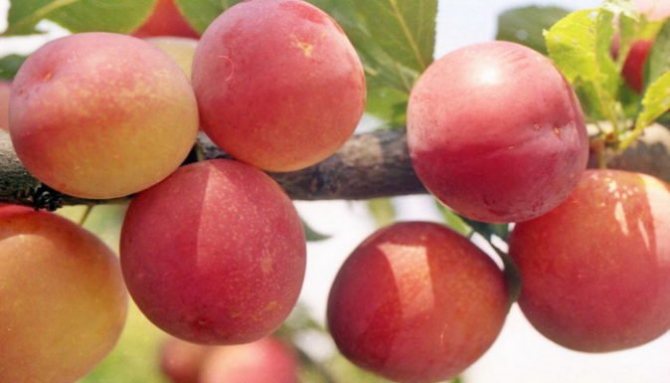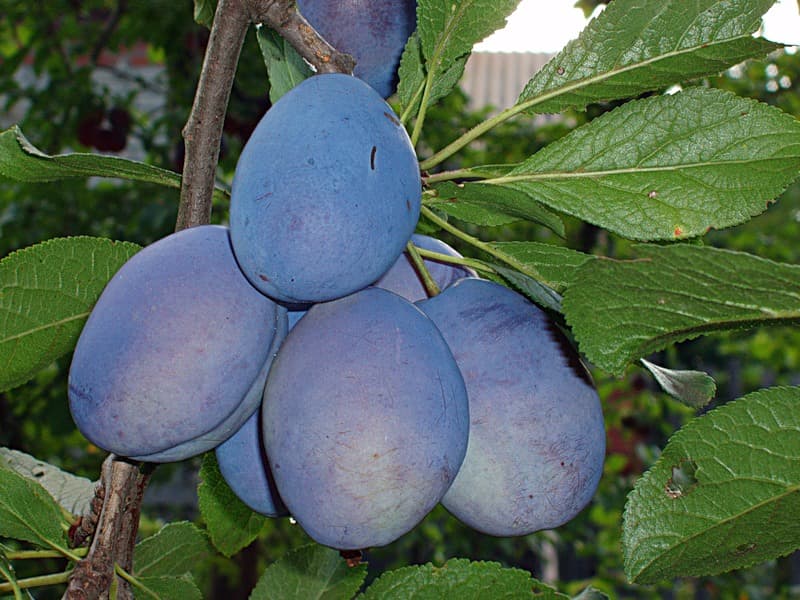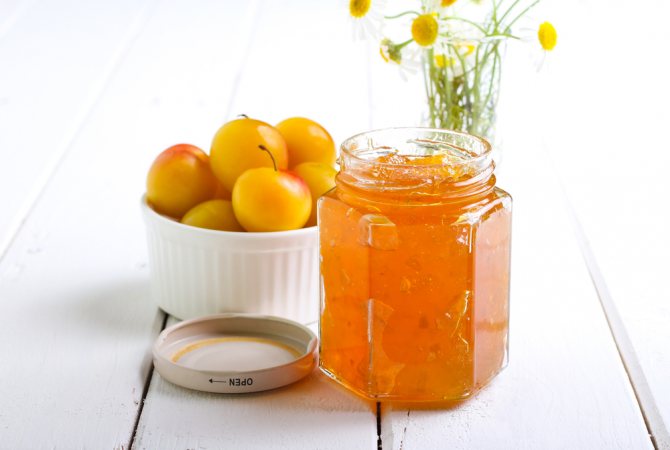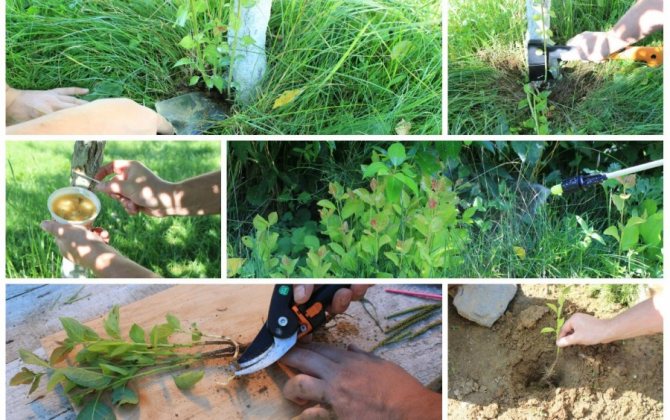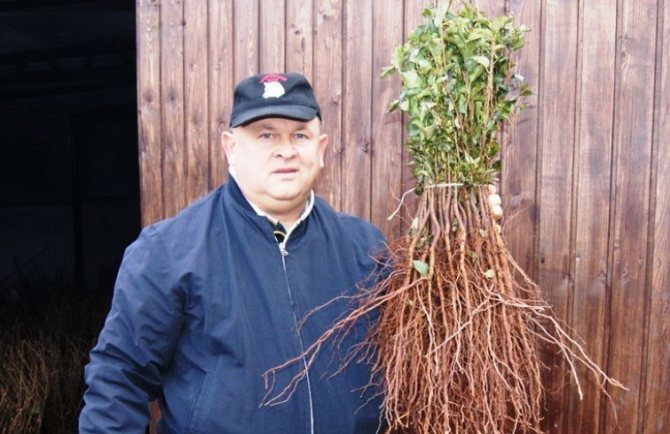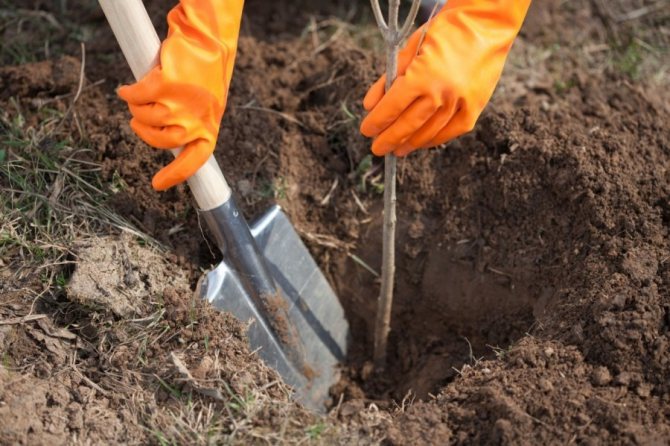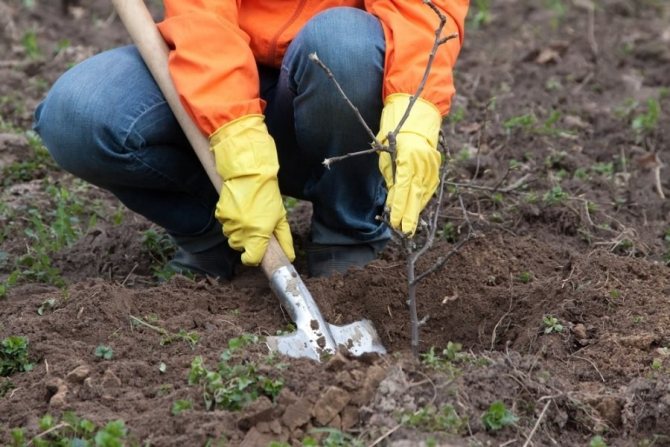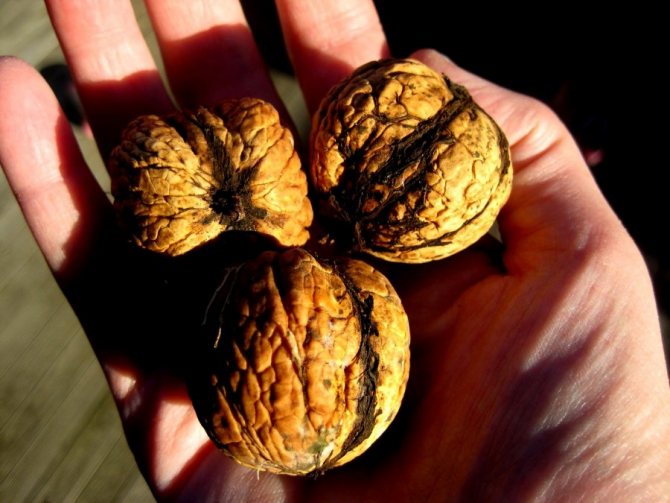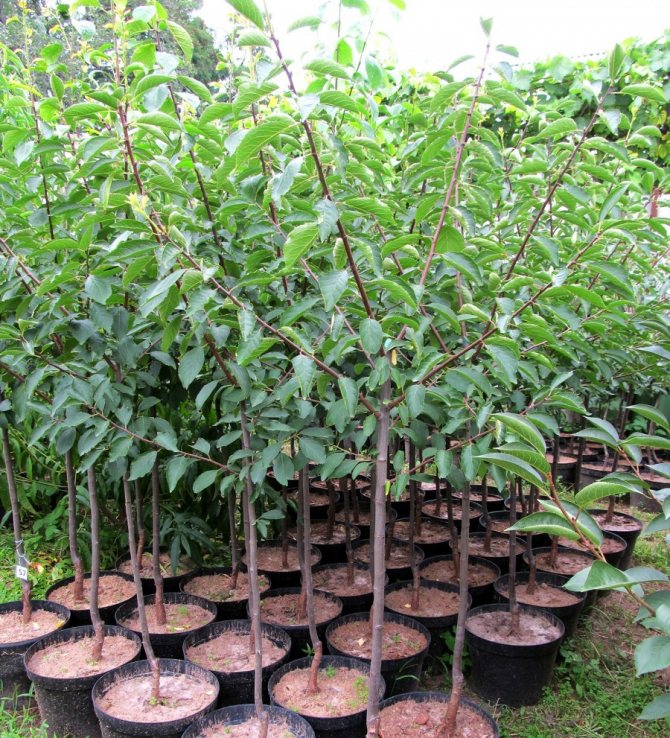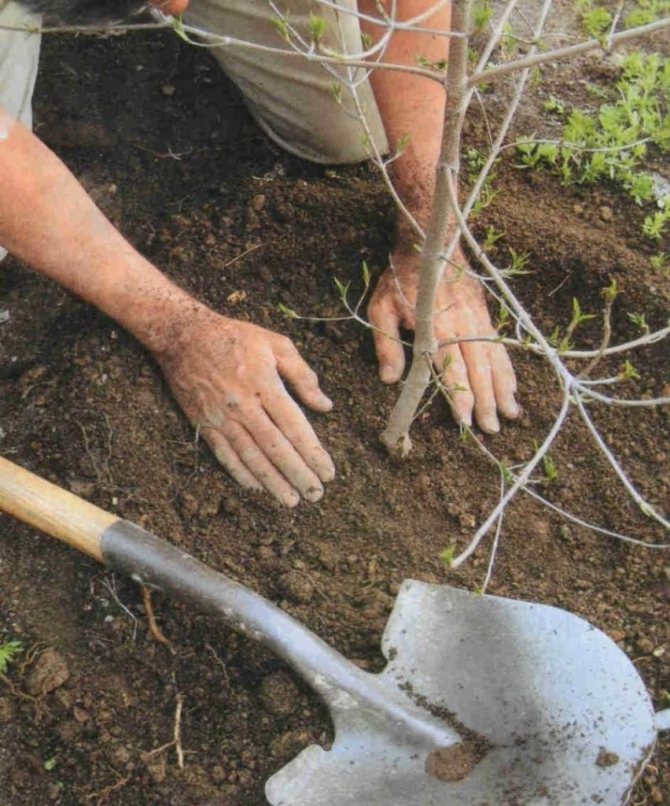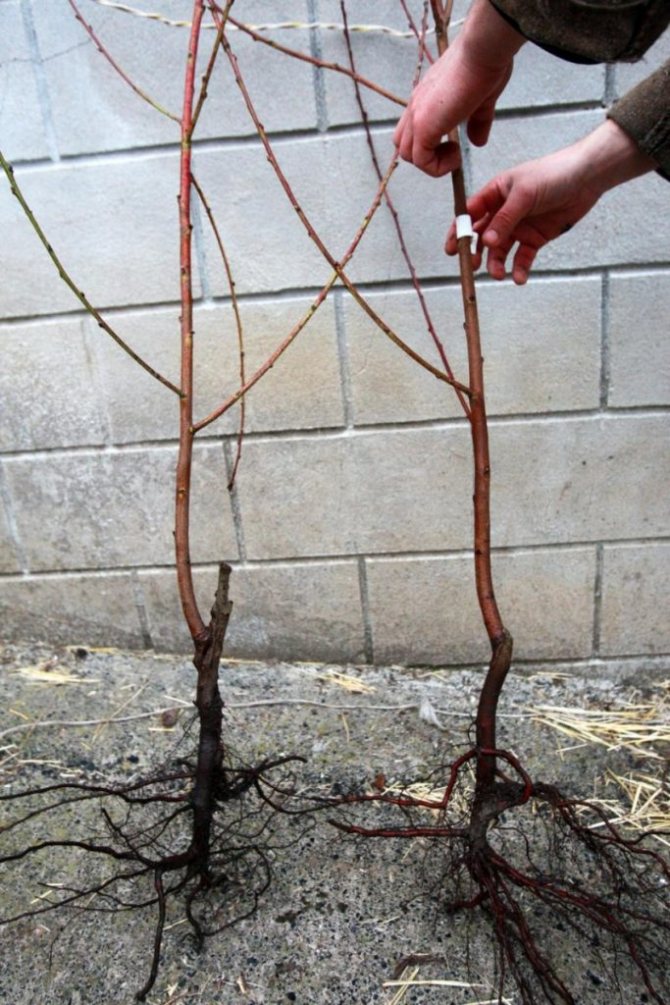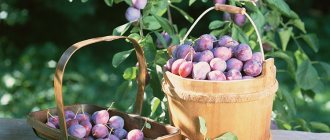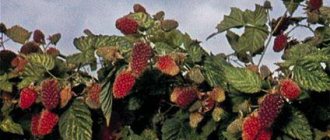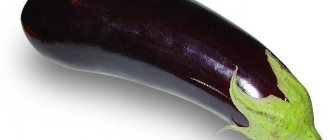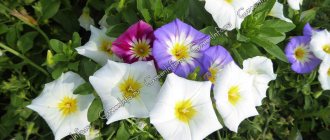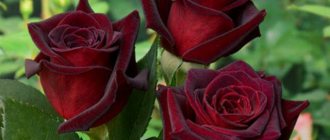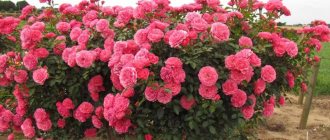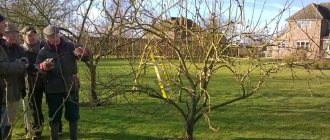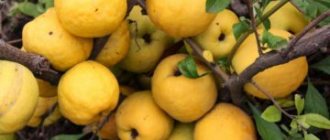- Characteristics of culture
- Benefits
- Bush
- Fruit
- Landing
- Care
- Reproduction
- Diseases and pests
- Conclusion
The plant from which all domestic varieties of culture originated - the wild plum - is completely in vain not grown by modern gardeners. It combines the best qualities of two fruit trees at once - cherry plum and blackthorn. Wild plum berries contain a lot of nutrients and trace elements, are widely used in folk medicine.

Review of common varieties of cherry plum
If you want to plant cherry plum on your site, the gardener needs to familiarize himself with the characteristics of the varieties. They are divided into groups depending on the ripening time, tree size, fruit indicators and other parameters.
In terms of ripening, early maturing, mid-maturing and late-maturing varieties are presented. Brief information about them is collected in the table below.
| Early ripe | Mid-season | Late ripening |
| Gold of the Scythians (Gold of the Scythians). Gives an average yield, golden fruits weighing up to 40 g. | Cleopatra. Medium-yielding species with large fruits reaching 50 g. The color of ripe cherry plum is dark purple, the flesh is red. | Golden autumn. Fruits are medium-sized, weighing 10 g. Advantage - the harvest remains on the branches until late autumn. |
| Traveler. It brings up to 40 kg of harvest per season, the weight of the fruit is up to 30 g, the color is yellow. | Kuban comet. Produces up to 40 kg of fruit. Fruits weighing up to 30 g, skin color is yellow. | Moscow Hungarian. Brings 20 kg of fruit weighing 25 g. Color is red. |
| Found. Begins to bear fruit in the third year, the mass of the yellow fruit reaches 37 g. | Huck. Yellow fruits weighing up to 45 g. The tree is capable of self-pollination. | |
| Ruby. Fruits are distinguished by dark red skin, orange pulp. | Morning. The tree is not tall. Fruit weight reaches 35 grams, yellow color. |
Also types of cherry plum differ in the size of the fruit. Their weight can range from 10 to 50 g. Trees with yellow, red and dark purple fruits are available to gardeners.
When choosing seedlings, you need to pay attention to the yield. The high-yielding varieties produce about 40 kg of fruit per year.
It is important to take into account the climatic zone where the landing will be made. For Siberia and the middle zone, it is recommended to choose species with high winter hardiness. You can take a variety with an average winter hardiness. With a significant drop in temperature, the shrub can be damaged, but later it is easily restored.
Main types
Split plum, denoting wild-growing species and cherry-like plum, uniting cultural forms - all this is cherry plum. It is divided into subspecies, which differ markedly from each other:
- Cherry plum Caucasian (typical). These are wild shrubs or trees common in Asia Minor, the Caucasus and the Balkans. The fruits are most often yellow, but sometimes they are found with a dark color. Their size is small, from 6 to 8 g. Plants form thickets in the mountains and foothills.
- Cherry plum east. Distributed in Afghanistan and Iran. It differs from the Caucasian one in smaller fruits. The taste is dominated by sourness and light astringency. Skin color varies from light yellow to dark purple.
- Cherry plum is large-fruited. Combines cultural forms that are not the last in gardens. Conditionally, they can be divided into varieties according to growing regions.Centuries of folk selection gave us Crimean cherry plum with large sweet and sour fruits and Georgian, more sour and tart, from which the famous Tkemali sauce is obtained. Tavricheskaya red-leaved (pissard) is very decorative. This cherry plum is widely used in landscape design, its fruits are also very tasty. There is also Iranian and Armenian.
Photo gallery: varieties of cherry plum
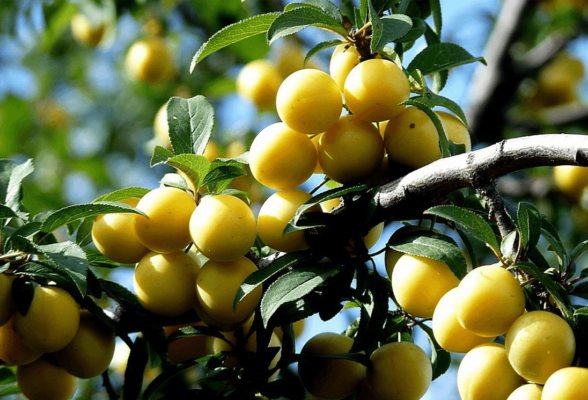

Eastern cherry plum grows in Afghanistan and Iran
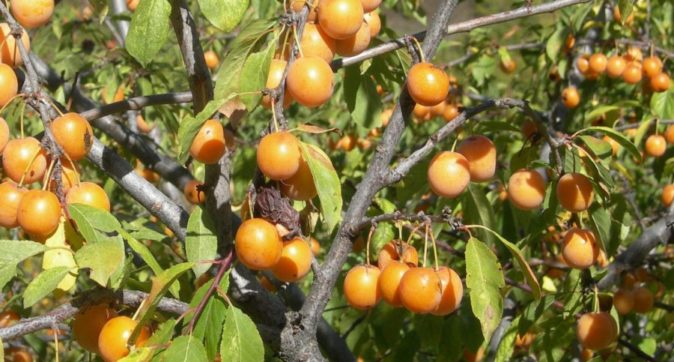

Tkemali sauce is made from Georgian cherry plum
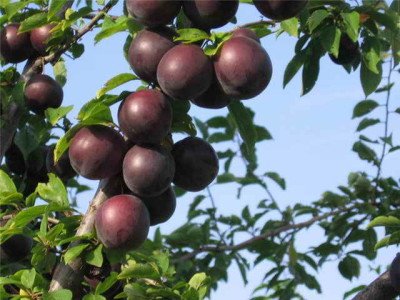

Caucasian cherry plum is a wild shrub or tree


The Crimean cherry plum has large sweet and sour fruits


The pissard has red leaves and is used in landscaping.
The best varieties of cherry plum
Some types of cherry plum are especially popular with gardeners. They are resistant to low temperatures and drought, and also produce bountiful yields.
Consider several large-fruited varieties:
- Tent. The tree is low, with a dense, rounded crown. It bears large fruits weighing up to 40 g. The skin has a dark purple hue, the flesh is yellow with a sweet and sour taste. Fruiting begins 4–5 years after planting, and a harvest of 35 kg can be obtained per season. Refers to early crops. Differs in high frost resistance and average drought resistance.
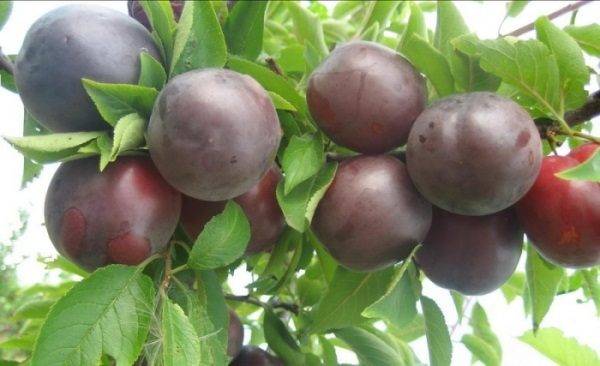

- Huck. Refers to mid-season varieties. The tree is not tall, in a short time it reaches its maximum size. The mass of one yellow fruit is up to 35 g. Gives a bountiful harvest, resistant to low temperatures.
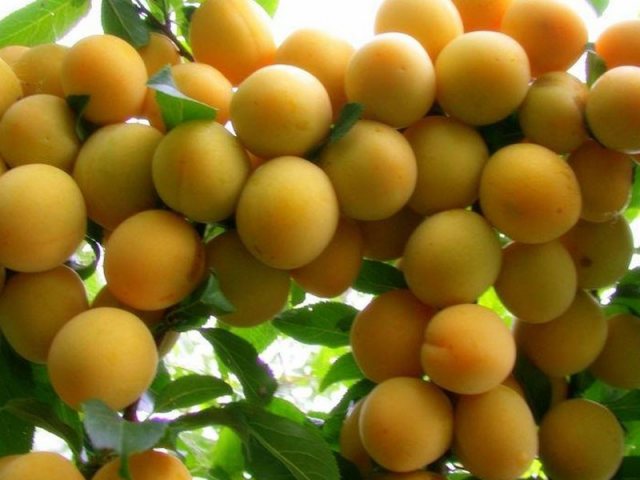

- Fast-growing. A compact shrub, fruiting begins as early as 2-3 years of age. Medium-sized fruit, yellow-red skin. The pulp is very pleasant to the taste, easily leaves the stone, therefore it is suitable for direct consumption. Resistant to low temperatures and winds.
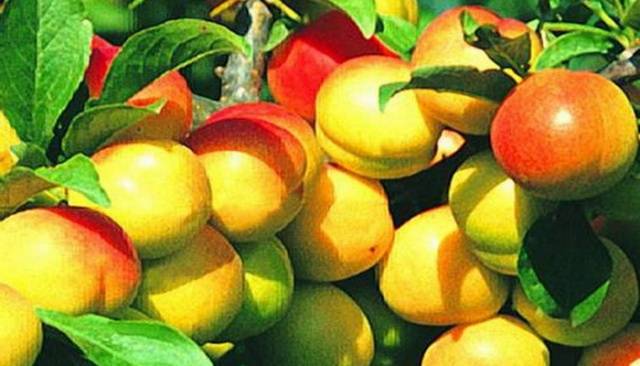

Above were listed the types of cherry plum that are loved by many gardeners. They are resistant to frost, so they can be successfully grown in regions with cold winters.
The choice of varieties depending on the region
The wide variety of cherry plum varieties puts gardeners, especially beginners, in a quandary. So that money and time are not wasted, you should not pay attention only to the size and color of the fruits, although this is also an important criterion. First of all, one should take into account the climatic features of a particular region. For example, planting southern varieties in Siberia is likely to fail.
The following varieties are suitable for certain regions:
- Kuban. Fertile soils and mild climate make it possible to obtain bountiful harvests of various crops here. They jokingly say that a stick stuck into the ground in the Kuban will bloom and bear fruit. This is not far from the truth. In this region, varieties with both low and high winter hardiness grow equally well. There are no restrictions on the ripening time either. Autumn in these parts comes late, often it is still warm in November, so the latest varieties have time to fully ripen. Suitable: Huck;
- The globe;
- Traveler;
- Abundant;
- Tent;
- Eugene;
- Chuk;
- Sun;
- Honey, etc.
- Duduk;
- Black velvet;
- Traveler;
- Crimean early;
- Sissy;
- Sissy;
- Gift to St. Petersburg;
- Princess;
- Duduk;
Classification of cherry plum varieties by ripening dates
Cherry plum varieties do not have a strict classification. However, depending on the ripening period, they are divided into early, middle and late. The first ones give harvest already in July – August. The ripening period of mid-season is the end of August. The later ones are filmed in September.
Early ripe
Nesmeyana is one of the early ripening varieties. The height of the tree can reach 6 meters, the harvest gives 3-4 years of life. Ripening begins in July. It is characterized by a red skin and a rounded shape. The weight of one piece reaches 30 g. Self-infertile variety, Cleopatra, Kuban comet, Traveler can act as a pollinator.
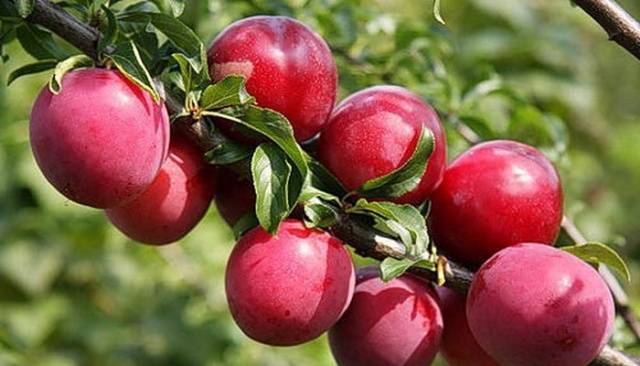

Important! The pollinator tree should be no more than 50 m away.
Sigma. A small tree with bountiful harvests. Refers to self-infertile species. Fruits with a yellow skin weighing up to 35 g, the pulp is difficult to separate from the stone.


Mid-season
Chuk. Reaches a height of 3-4 m, gives about 30 kg of harvest per year. Fruit of a dark purple hue weighing 30 g. It is characterized by medium resistance to low temperatures. Self-infertile, a Chinese plum or other cherry plum is suitable as a pollinator.Produces a stable harvest, resists diseases.
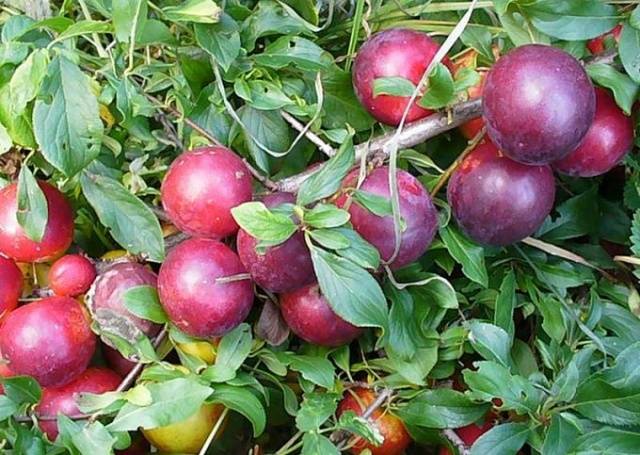

Peach. It has sweet flesh and red-burgundy skin. It tastes like a peach, which is reflected in the name.


Late ripening
Moscow Hungarian. A tree of medium height, self-fertile. Fruits ripen, weighing 25 g, juicy, with red skin. Medium frost resistance.
Cleopatra. A medium-sized tree with a high yield. It bears fruits of a dark purple hue weighing up to 37 g with delicious red pulp. Refers to self-infertile species.
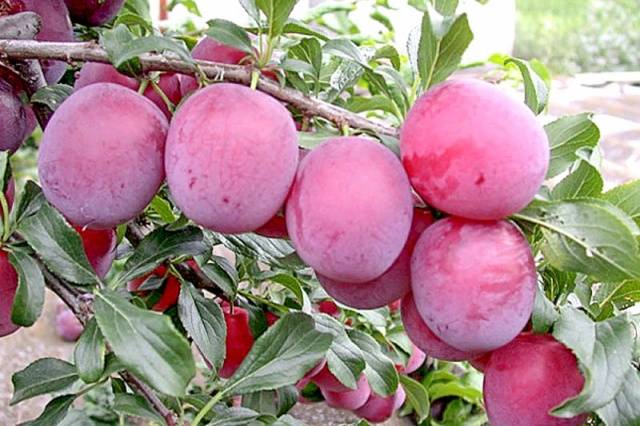

The use of cherry plum in cosmetology
Cherry plum seed oil is often used in cosmetic products and natural soaps. Cherry plum juice relieves skin inflammation and helps fight acne. Creams and masks, which contain cherry plum, have a particularly beneficial effect on oily skin.
Face lotion
For 100 ml of warm water, take 50 g of cherry plum pulp. The mixture is infused for 12 hours, filtered and used in the morning. The same composition can be used as a hair rinse to help strengthen hair follicles.
Large-fruited cherry plum
General belongs to one of the largest-fruited types of cherry plum. The mass of fruits can reach 80 g, they are located on the branches separately. The variety is resistant to frost, is considered early maturing.
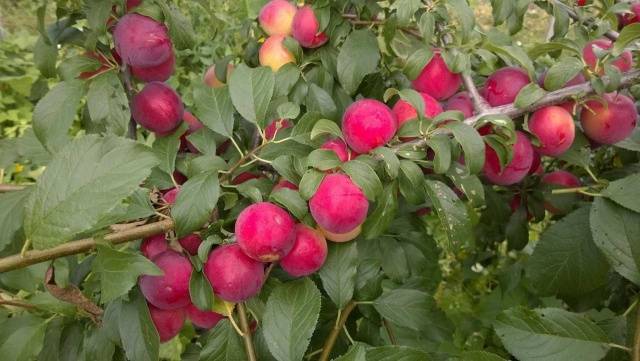

Globus is a large-fruited variety, the weight of one piece can reach 100 g. It is a hybrid obtained by crossing the Abundant variety, the Kulturnaya red hybrid and the apricot. If the harvest is plentiful, the fruits are smaller, but still reach a weight of 50-60 g. The color of the skin is dark blue, the pulp is yellow, juicy. Due to the intensive growth, the branches should be pruned regularly.
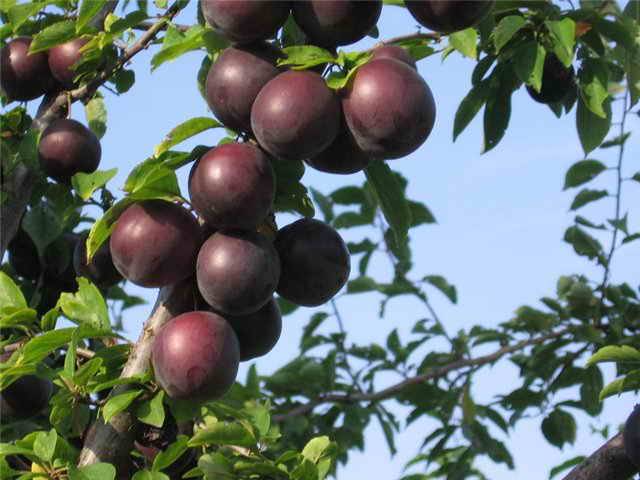

Diseases and pests
Despite the fact that this type of pink family is resistant to the effects of various microbes, the shrub can still get sick.
- Peripheral rot is a disease that affects young shoots of wild plum. In order to avoid the spread of infection, infected seedlings are completely removed.
- Moniliosis - this type of fungus affects the shoots of wild plum. The foliage turns brown-brown, new shoots die off. The disease affects the appearance of the fruits: the berries lose their neat shape, change color, becoming covered with a brown bloom. If the affected fruits are not removed in time, in spring they can become a source of infection for the entire plant.
Fungicides will help fight these diseases. Horus solution, Abiga-Peak, Gamair, Rovral, Bordeaux mixture and copper sulfate are suitable. Read the manufacturer's instructions carefully before using these products.
Aphids are the most dangerous insect for this plant. As a result of the harmful effects of an insect, the stem of a wild plum is destroyed. The plant begins to turn yellow, bend and disappear. To destroy the pest, the shrub is treated with an acaricide solution.
After planting seedlings, observe them during the first months. The tree will definitely signal you about the deterioration of its health. If you are quick and react in time, you can avoid the development of a serious illness.
Self-fertile varieties of cherry plum
Kuban comet. One of the self-fertile species that does not require a pollinator to be planted nearby. Fruits have a relatively low weight - up to 28 g. The hue of the skin is reddish, the flesh is yellow with a sweet and sour taste. The tree is not very tall, it brings up to 40 kg of harvest per year. Needs regular watering.


Mara. Another self-fertile variety with high resistance to frost and disease. The height of the tree is 2-3 m, it forms a spherical crown. It bears fruit with a rich yellow color. Ripening occurs at the beginning of July, while the harvest will not fall until the first days of August. The pulp is very sweet in taste.
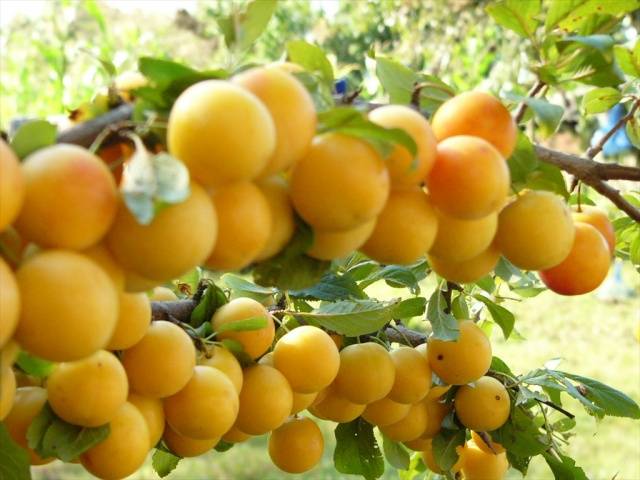

Care
Wild plum (thorn) does not need complex care manipulations.Having planted a shrub, it must be cut off, and next spring the crown is shaped. Plant care includes:
- regular watering. During the first month, the shrub should be watered once every seven days, then the time between treatments is increased to two weeks. After the seedling is taken in and releases the first shoots, watering becomes more rare (wild plum will have enough natural precipitation). During a period of severe drought, you can water the bush with three buckets of water once a month;
- preparation for wintering;
- harvesting;
- pruning excess shoots, dry and diseased branches. In the process of the first pruning, you need to leave no more than 5-7 main fruiting branches, because the shrub grows rapidly. Autumn pruning: November, after foliage has fallen;
- the introduction of nutrients (in spring and autumn, the bush should be watered with humus or superphosphates);
- loosening the soil;
- weed control.
Hybrid varieties of cherry plum
Abundant. This hybrid was bred in 1969 and is suitable for growing in the North Caucasus region. Fruits have a pleasant taste and aroma, the weight is 30 g or more. The skin is dark purple in color. Differs in abundant fruiting.
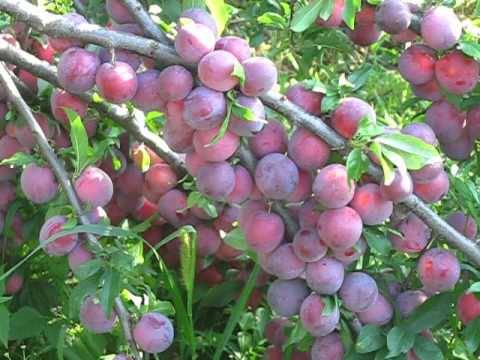

Dessert. It was obtained by crossing a Chinese plum and a variety called Tauric. A tree of medium height, forms a drooping crown. Fruits grow weighing 30–35 g, the skin is dark red. The pulp is dense, orange. Low frost resistance is characteristic.
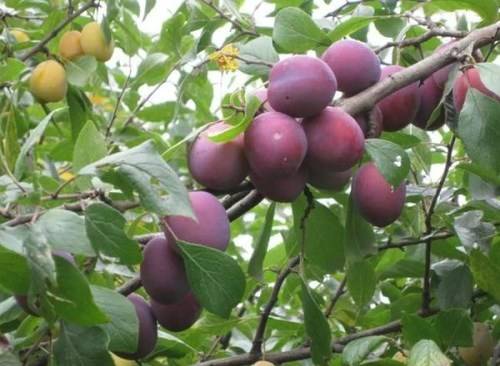

Name
The Latin name for cherry plum - Prunus cerasifera, which literally means "plum with cherry fruits". This name was used by the Swiss botanist Jacob Erhart.
Alternative names
In Russian scientific sources, cherry plum sometimes appears as a splayed and cherry-bearing plum. There are also options: cherry sliva, mirabelle, mirabolan. In Georgia, cherry plum is known as "tkemali", which gave the name to the world famous sauce.
Red-leaved cherry plum varieties
The llama will not only bring a bountiful harvest (40-50 kg per tree), but also become a decoration of the garden. Fruits have a sweet and sour taste, their weight varies within 30-40 g. Low-growing shrub no more than 2 m in height. The peculiarity of the Lama is its reddish leaves. Ripe fruits crumble easily in strong winds. Cultivation is possible in the middle lane, the North-West region and Siberia.
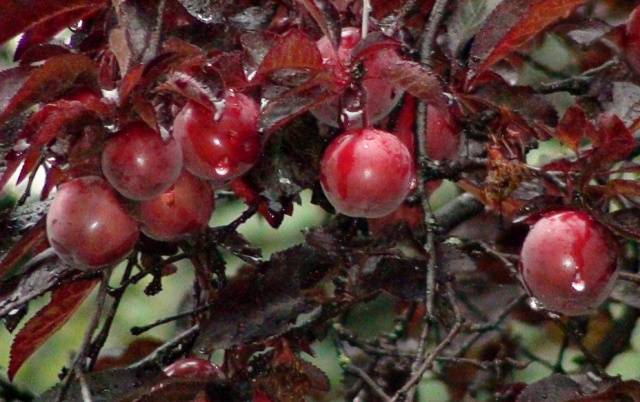

Advantages and disadvantages
Among the advantages it is worth noting:
- widespread use;
- frost resistance - flowers easily tolerate a drop in temperature to -8 degrees Celsius, ovaries - up to -2 ° C;
- high fruiting rate;
- drought resistant.
Among the shortcomings it is worth adding:
- contraindications for use: gout, gastrointestinal diseases, allergic reaction, age up to 12 years;
- poisoning and heartburn in case of excessive consumption of the product;
- fastidious in care - lack of attention can lead to a shrinking crop;
- the need to plant several trees to obtain a crop.
Summing up, it is worth noting that not only the distinctive features of the cherry plum culture and tips for caring for it were presented, but also the advantages, disadvantages and areas of application of the tree were considered, after studying which it will be easier to decide whether to plant this fruit in the garden or not.
How cherry plum is classified by shades
Another sign by which cherry plum varieties are classified is the color of the fruit. It can vary from yellow to deep purple and almost black.
Yellow cherry plum
Tsarskaya. It bears small yellow fruits weighing up to 20 g. They ripen by the beginning of August, are valued for their excellent taste and transportability. They are rich in citric acid and contain a lot of sugar. The tree is medium-sized, begins to bear fruit in the second year after planting.
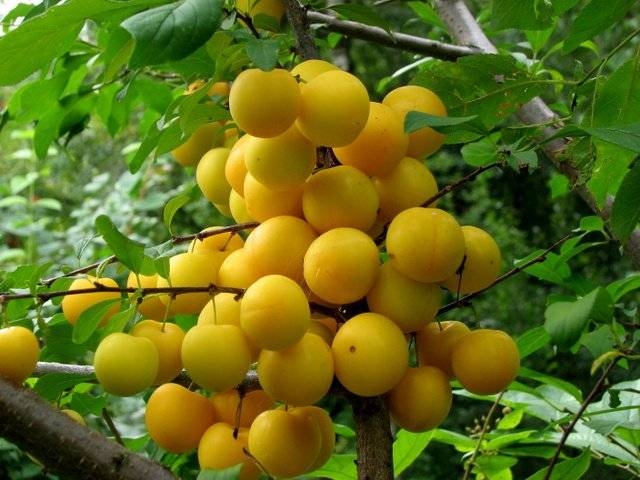

Oriole. It grows a little over 5 m high, bears fruit regularly and abundantly. Differs in resistance to heat and lack of moisture. Yellow color. Ripens at the end of July.
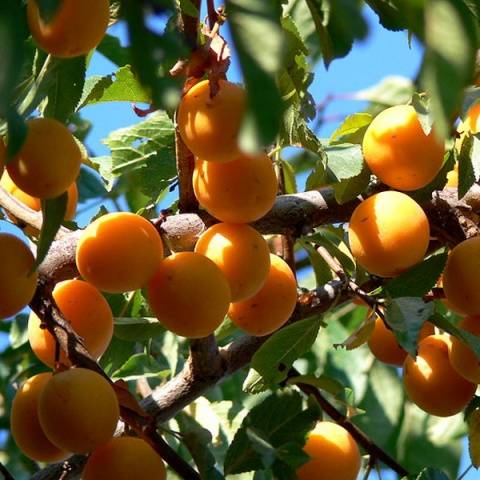

Cherry plum with red fruits
The July rose bears elongated red fruits weighing up to 40 g. The tree is of medium height. It can bear fruit without a pollinator, however, if available, it will give a greater yield.


Green cherry plum
Unripe cherry plum is used in cooking as part of sauces and side dishes. Green fruits are high in citric acid. By supplementing the dish with such a seasoning, you can improve both its taste and digestibility.
Cherry plum with purple fruits
Found. A large-fruited variety with an early ripening period. Fruiting begins as early as 3 years of age, the weight of the crop can reach 40 kg per year. Fruits of violet color with yellow pulp weighing up to 35 g. Resistance to temperature extremes is high, to lack of moisture - medium. For pollination, other species should be planted nearby, blooming at about the same time.
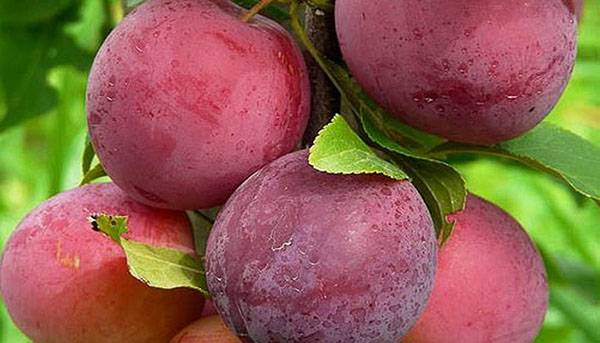

Introduction
Russian plum (Prunus rossica Erem.) Occupies a prominent place among fruit plants new to Russia.
The biological features of the Russian plum - adaptability, productivity, early ripening of fruits, early and abundant fruiting - allow the use of intensive technologies in the plantings of this culture, which further contributes to the manifestation of these qualities and obtaining a high economic effect from its cultivation.
In recent years, new valuable varieties of Russian plum have been identified, as well as clonal rootstocks of various growth rates, which can be successfully used to create highly productive plantings of this culture. The fruits of the best varieties of Russian plum are valuable for fresh consumption and for the preparation of high-quality canned food. It became possible to select the best of them and to recommend the most promising variety-rootstock combinations for their use in intensive technologies in the cultivation of Russian plum. For this purpose, studies are being carried out at the Crimean OSS of the SKZNIISiV, the first results of which are presented in this work.
Taste characteristics of cherry plum varieties
A variety of flavors was made possible by crossing cherry plum with some types of plums. As a result, hybrids appeared, differing in other characteristics: color, ripening time, growing regions.
Sweet varieties of cherry plum
Apricot. Quite large fruits resemble apricots. The skin is yellow-pink. The pulp is yellow-orange, juicy, sweet in taste. Ripening occurs during August. Withstands frosts, but as a result of sharp temperature fluctuations, the yield decreases.
Sweet and sour cherry plum
Sonya. A short tree, reaching 3 m. It bears yellow fruits with a sweet and sour taste, weighing in the range of 40-50 g. The harvest ripens by the beginning of September. Refers to early-growing varieties, fruiting begins 2-3 years after planting. Frost resistance allows you to grow it in the middle lane.
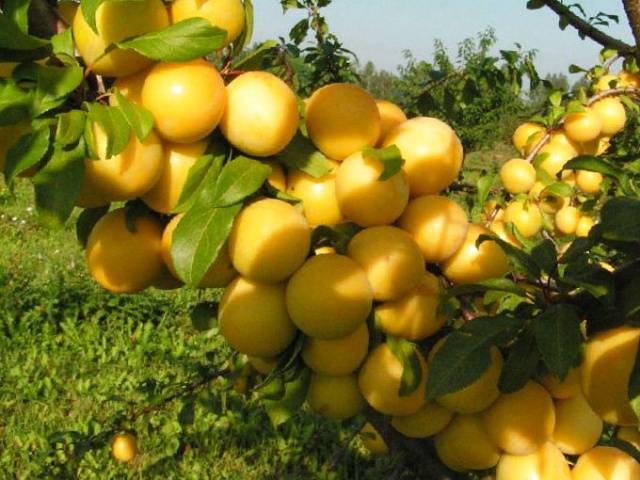

Recipes
Bark infusion for the treatment of colds with coughs
Crushed bark weighing 20 g is poured into 500 ml of water and boiled for 6-8 minutes. The cooled filtered broth is drunk in 100 ml 4-5 times a day.
Decoction of flowers for diseases of the liver, kidneys
For 20 g of raw materials, 250 ml of boiling water is taken, in which they are infused for 2 hours. Then the infusion is filtered and taken during the day in 2 equal doses.
Return erection for men
300 ml of warm water is poured onto 100 g of cherry plum flowers and kept in a closed container for 24 hours. The filtered infusion is drunk in one go.
To relieve constipation
Take 60 g of dry fruits, pour them with 2 cups of boiling water, bring the mixture to a boil again and leave for at least 4 hours. The filtered infusion is drunk in 100 ml before meals.


What to consider when choosing seedlings
To get a bountiful harvest every year, you must choose the right variety. In this case, the gardener will focus on the following points:
- Climatic zone. If planting is planned in the middle lane or in Siberia, you need to choose seedlings with good winter hardiness.
- Ripening period.When several trees are planted on the site with different periods of fruiting, you can provide yourself with a constant harvest for the entire season.
- Fetal characteristics. Here you should pay attention to size, color, taste. This information can be found in the description.
- The height of the tree. It is selected in accordance with the characteristics of the site.
When the choice is made, you can go to the nursery. It is recommended to purchase 4-year-old seedlings grown in the home region, as they take root better after planting on the site.
Characteristics of culture
Wild plum is a plant whose fruits have the juiciness and taste of cherry plum and winter hardiness and the velvety color of thorns. The shrub can be grown naturally or specially grown in the garden.
Tern got its name from the Slavic "thorn", was known in the days of Ancient Rome. The usual habitat is the forest-steppe, so the wild plum can often be found in Europe, Asia Minor, Ukraine, Russia and the Caucasus.
The best varieties of cherry plum for the Moscow region
It is best to purchase seedlings in local nurseries. In the markets you can buy a southern variety that is not adapted to the climate of the Moscow region.
Self-fertile varieties of cherry plum for the Moscow region
Columnar. A tree of unusual shape - the height reaches 3 m, while the diameter of the crown is not more than 1.5 m. The variety is winter-hardy: it quickly recovers after freezing. Fruits grow in weight up to 40 g. The skin is red, the pulp is juicy, with a pleasant taste. This variety is resistant to diseases and pests.
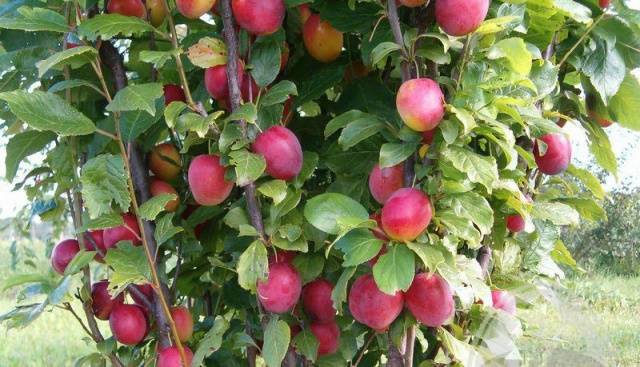

Sweet varieties of cherry plum for the Moscow region
Gold of the Scythians (Gold of the Scythians). A low tree (up to 3 m) with a crown in the form of a wide cone. Fruit of a golden hue with a delicate, very sweet pulp. The variety is resistant to sharp temperature fluctuations.
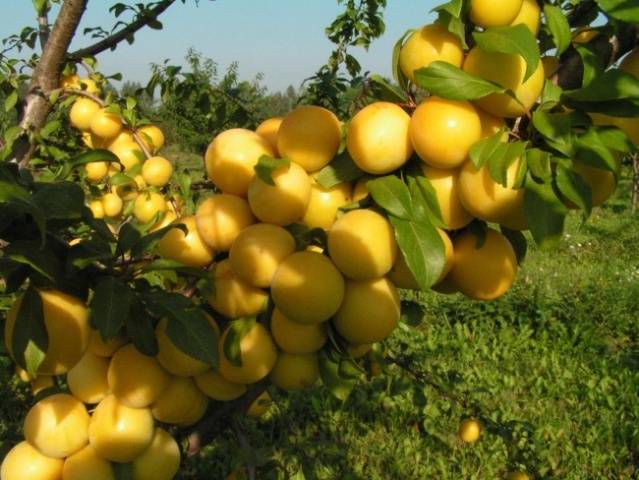

Ruby. The skin is burgundy, the flesh is dark yellow. Ripe fruits also lack acidity. Does not suffer from sudden changes in temperature and does not require complex maintenance.


The discussion of the results
2005-2010, when the experimental plants were observed, fell on the period of growth and fruiting (according to P.G. Shitt). The weather conditions of these years are characterized as extremely unfavorable for the growth and fruiting of Russian plum trees - drought in 2007 and dry period in other years. Frosts in the winters of 2005-2006, 2009-2010, frosts during the "flowering" period in 2009. All this led to the weakening and freezing of trees, the complete death of the harvest in 2009 and significant (to complete) in some varieties in 2010. As a result, only two harvests of the Russian plum were obtained for the indicated period, and in 2009 the harvest was completely destroyed. Nevertheless, the information obtained as a result of observations on the nature of growth, fruiting and other indicators of biology allows us to draw preliminary conclusions about the peculiarities of the biology of variety-rootstock combinations in Russian plum in the first years of their growth in the garden.
The rapid growth of tree biomass characteristic of this culture is of paramount importance for the productivity of Russian plum plantations. This allows trees of Russian plum varieties to lay a sufficiently large number of flower buds already for 3-4 years, which predetermines their early entry into fruiting and the formation of a sufficiently large harvest of fruits, both in the first and subsequent years of fruiting.
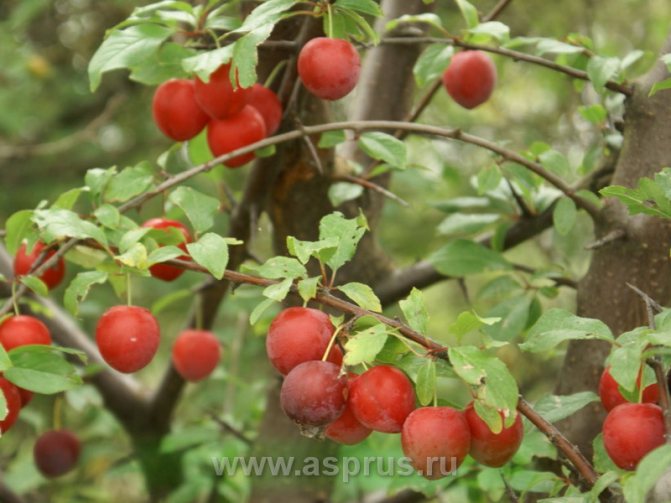

Industrial variety of cherry plum Kuban comet
By the nature of strength and other features of growth, trees of various varieties-rootstock combinations differ significantly from each other.
There are differences in growth among the various varieties of Russian plum grafted on the weakly grown rootstock VVA-1. Three groups of varieties differ among themselves according to this indicator:
Group 1 - the most vigorous variety-rootstock combinations of varieties: July rose, Gek, Evgeniya, Abundant;
Group 2 - medium-sized variety-rootstock combinations with the participation of varieties: Kuban comet, Shater, Naydena, Traveler, Globus, Late comet;
Group 3 - varietal-rootstock combinations, the trees of which have low-volume crowns: Columnar [3].
For the formation of a full-fledged garden agrocenosis, the duration of the period of development of the allotted tree feeding area is of great importance (Table 1).
Table 1
Biometric indicators of growth of trees of varieties of Russian plum on clonal rootstock VVA-1, 2010, planting 2005, Crimean OSS
| Variety | Rootstock | Landing scheme, m | Height of trees, m | Crown diameter, m | Crown projection area, m2 | Crown volume, m3 | Boom diameter, cm | Cross-sectional area of the trunk, cm2 |
| July rose | VVA-1 | 5x1.5 | 2,5 | 3,20 | 8,02 | 13,4 | 8,6 | 58,0 |
| Kuban comet | — // — | — // — | 2,1 | 2,85 | 6,36 | 8,9 | 4,6 | 16,6 |
| Tent | — // — | — // — | 2,3 | 2,60 | 5,29 | 8,1 | 6,1 | 29,2 |
| Traveler | — // — | — // — | 2,4 | 2,65 | 5,50 | 8,8 | 5,0 | 19,6 |
| Found | — // — | — // — | 2,2 | 2,60 | 5,29 | 7,8 | 5,9 | 27,3 |
| Late comet | — // — | — // — | 2,6 | 2,25 | 3,96 | 6,9 | 5,7 | 25,5 |
| Huck | — // — | — // — | 2,3 | 3,40 | 9,06 | 13,9 | 6,9 | 37,3 |
| Columnar | — // — | — // — | 2,9 | 1,15 | 1,03 | 2,0 | 5,5 | 23,7 |
| the globe | — // — | — // — | 2,7 | 2,75 | 5,92 | 10,6 | 5,5 | 23,7 |
| Evgeniya | — // — | — // — | 2,3 | 3,70 | 10,70 | 16,4 | 6,4 | 32,1 |
| Abundant | — // — | — // — | 2,8 | 3,05 | 7,29 | 13,6 | 7,0 | 38,4 |
| NSR05 | 0,3 | 0,7 | 2,6 | 4,1 | 1,1 | 11,6 |
The shorter it is, the faster the variety-rootstock combination is and the faster the full fruiting period will begin.
Since the technological lane, free for the passage of equipment, in the row spacing is considered to be at least 2 m, the crown width towards the row spacing in our experimental plantations is allowed up to 3 m, which is close to the optimal sizes for the development of trees of medium-sized variety-rootstock combinations, but somewhat large for trees on weak rootstocks. They mastered the area of the projection of the crown of 3 x 1.5 m allotted to them by the age of 4.
The fastest of all the varieties studied on the clonal rootstock VVA-1 - by the age of four they mastered the area allotted to them: Evgenia, Gek, July Rose, Abundant. In the same varieties, the crown volume also increased most rapidly on the VVA-1 rootstock.
Also, in four years, they mastered the area allocated to them and their own rooted trees of the Kuban comet variety.
The fastest increase in crown volume was also observed in self-rooted trees of the Globus and Kuban comet varieties.
Trees of Russian plum varieties on a weak rootstock VVA-1 were originally 1.5-2 times smaller than those of their own roots. In the row, the crowns of the trees of most varieties of Russian plums began to close by the end of 2-3 growing seasons. Most of all - for 3 years, the closure of trees in a row was noted in the following varieties: Traveler, Nayden, Gek, Evgeniya, Obilnaya. For 5 years they have not mastered the area allotted to trees grafted on VVA-1 varieties Kolonnovidnaya and Kometa late. This allows us to consider for the latter more than 1.5 m between trees thickening in rows is possible, while for other varieties of Russian plum, cherry plum, this distance is close to optimal.
The tallest trees on the VVA-1 rootstock at the age of 5 years were trees of the varieties Kometa late, Kolonnovidnaya, Gek, Globus and Abundant - over 2.5 m. Apparently, at this age, it is already necessary to carry out for trees of these variety-rootstock combinations of frame pruning with limiting their growth in height.
In general, it can be assumed that when forming Russian plum plantations of the “fruit wall” type with the use of a weak rootstock VVA-1 already for 3-4 years, and on a medium-sized rootstock by the age of 5, they are sufficiently formalized and ready for commercial fruiting (Fig. 1, 2.).


Fig. 1 Kuban comet / own-rooted
When selecting varieties for high-intensity plantations, one of the limiting factors is the presence of inter-pollinated varieties. Of no small importance is the timing of the onset of fruit ripening for planning the receipt of products.
Differences between them in the passage of individual phenophases are of certain importance for assessing the feasibility of using different variety-rootstock combinations [2].


Fig. 2 Cherry plum on VVA-1 rootstock
In particular, grafting on clonal rootstocks often somewhat accelerates the passage of phenophases in Russian plum varieties, especially when using the clonal rootstock VVA-1.
Continued observations of the passage of phenophases in variety-rootstock combinations of Russian plum showed that trees on the VVA-1 clonal rootstock somewhat accelerate the timing of the onset of growth and flowering in comparison with self-rooted trees (Table 2).
table 2
Flowering features of various varieties of Russian plum (rootstock VVA-1, planting pattern 5 x 1.5 m, planting garden 2005)
| Variety | Rootstock | Bloom | Maturation | |||
| 2008 r. | 2009 r. | 2010 | 2008 r. | 2010 r. | ||
| July rose | VVA-1 | 02.04 | 27.03 | 05.04 | 16.06 | 15.06 |
| Kuban comet | — // — | 06.04 | 29.03 | 07.04 | 20.06 | 21.06 |
| Tent | — // — | 03.04 | 30.03 | 07.04 | 20.06 | 25.06 |
| Traveler | — // — | 07.04 | 03.04 | 10.04 | 22.06 | 26.06 |
| Found | — // — | 06.04 | 28.03 | 07.04 | 25.06 | 28.06 |
| Late comet | — // — | 10.04 | 04.04 | 10.04 | 25.06 | 04.07 |
| Huck | — // — | 06.04 | 30.03 | 08.04 | 27.6 | 02.07 |
| Columnar | — // — | 07.04 | 02.04 | 02.04 | 25.07 | 27.07 |
| the globe | — // — | 30.03 | 29.03 | 01.04 | 23.07 | 20.07 |
| Evgeniya | — // — | 07.04 | 01.04 | 07.04 | 24.06 | 23.06 |
| Abundant | — // — | 10.04 | 02.04 | 12.4 | 04.07 | 12.07 |
| Kuban comet | Own-rooted | 12.04 | 04.04 | 14.04 | 29.06 | 30.06 |
| the globe | Own-rooted | 08.04 | 06.04 | 15.04 | 02.08 | 29.07 |
By the duration of flowering, all variety-rootstock combinations approached or were equal to the control.
For Russian plum, the influence of the rootstock on the ripening of fruits in the scion variety is very significant. The observations made it possible to establish that clonal rootstocks significantly affect this most important phenophase towards a shift towards an earlier passage. Almost all clonal rootstocks caused earlier maturation in all studied varieties.
Productivity is the most important indicator of the productivity of a fruit crop, which is determined by the biological characteristics of the variety, as well as the influence of weather conditions and stress factors on it. An important place in this series is occupied by the correct selection of variety-rootstock combinations, based on the location of the garden and the planting scheme, the system of soil maintenance, the presence of a system of mineral nutrition and protection of the plant from major diseases and pests, the optimization of which during the period of crop formation is the main condition for full implementation. the productive potential of the Russian plum plant.
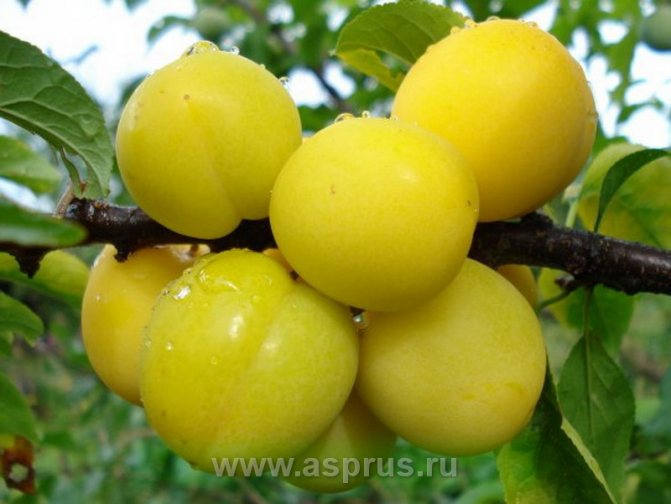

Industrial variety of cherry plum Gek
On the weakly growing clonal rootstock VVA-1, already in the third year of growth, a high yield was obtained on trees of the Shater, Traveler and Globus varieties. The varieties Kubanskaya Kometa, Kometa Late, Evgeniya, Obilnaya and Cherry Plum Purpurovaya at the age of three years of trees yielded worse than others. Attention is drawn to the fact that the first three varieties are close relatives. This suggests that the lower early maturity of these varieties in comparison with the Shater, Traveler and Globus varieties has one genetic basis.
At the age of five, trees of the variety-rootstock combination Traveler / VVA-1 stood out for their outstanding productivity. Traveler less than other varieties of Russian plum suffered from frost -24 ° C at the end of January after the thaw and better than other varieties realized its high early maturity (Table 3).
Table 3
Productivity of varieties of Russian plum and cherry plum on clonal rootstock VVA-1, Crimean OSS
| Variety, planting scheme | Rootstock | Yield | Average specific productivity | |||||||
| 2008 r. | 2010 | average | ||||||||
| kg / der | t / ha | kg / der | t / ha | kg / der | t / ha | for 1m2 crown projection | per 1 m3 of crown volume | per 1 cm3 of the cross-section of the trunk | ||
| July rose (5x1.5 m) | VVA -1 | 3,8 | 5,10 | 2,9 | 38,6 | 3,3 | 4,48 | 0,89 | 0,49 | 0,17 |
| Kuban comet (5x1.5 m) | — // — | 0,6 | 0,80 | 4,6 | 6,13 | 2,6 | 3,40 | 0,57 | 0,38 | 0,19 |
| Tent (5x1.5 m) | — // — | 16,8 | 22,4 | 8,1 | 10,8 | 12,4 | 16,6 | 4,07 | 2,70 | 0,96 |
| Traveler (5x1.5 m) | — // — | 12,5 | 16,6 | 42,0 | 56,0 | 27,2 | 36,3 | 5,90 | 3,33 | 1,56 |
| Found (5x1.5 m) | — // — | 5,4 | 7,20 | 22,3 | 29,7 | 13,8 | 18,4 | 2,82 | 1,84 | 0,43 |
| Late comet (5x1.5 m) | — // — | 1,5 | 2,00 | 1,8 | 2,40 | 1,6 | 2,20 | 0,71 | 0,36 | 0,10 |
| Huck (5x1.5 m) | — // — | 6,0 | 8,00 | 4,3 | 5,73 | 5,1 | 6,80 | 0,99 | 0,63 | 0,34 |
| Columnar (5x1.5 m) | — // — | 8,0 | 10,6 | 9,2 | 12,2 | 8,6 | 11,4 | 5,53 | 4,83 | 0,60 |
| Globe (5x1.5 m) | — // — | 13,0 | 17,3 | 13,6 | 18,1 | 13,3 | 17,7 | 3,45 | 1,43 | 0,60 |
| Evgeniya (5x1.5 m) | — // — | 0,7 | 0,9 | 2,6 | 3,46 | 1,6 | 2,15 | 0,20 | 0,11 | 0,40 |
| Abundant (5x1.5 m) | — // — | 3,2 | 4,26 | 0,3 | 0,40 | 1,7 | 2,30 | 0,71 | 0,23 | 0,12 |
| NSR05 | 5,5 | 7,4 | 12,5 | 17,9 | 8,0 | 10,7 | 2,1 | 1,6 | 0,4 | |
Despite the freezing of flower buds, it is quite satisfactory - the grafted on VVA-1 varieties Shater, Nayden, Globus, Kolonovidnaya, grafted fruit better than others. Yul'skaya rose, Kometa late, Eugenia, Abundant, and Purple cherry plum yielded poorly on this rootstock.
According to the results of two years of fruiting, the fastest growing varieties when grafted on VVA-1 can be considered the varieties of the Russian plum Traveler, Nayden, Shater, Globus. The same varieties are also characterized by the highest specific productivity in terms of 1 m2 of crown projection, 1 m3 of crown volume and 1 cm2 of the trunk cross-section. The Kolonnovidnaya variety is also characterized by outstanding indicators of specific productivity. This feature is advisable to implement with a greater thickening with the use of superintensive shaping. Among the most productive in the first years of fruiting can be included the variety-rootstock combinations of the VVA-1 rootstock with the varieties of the Russian plum Kometa late, Obilnaya.
On the VVA-1 clonal rootstock, the fruits of all varieties of Russian plum grafted on it were smaller than on own-rooted trees. (fig. 3.).


Fig. 3. Cherry plum on VVA-1 rootstock
This was due to the fact that, with a sufficiently large load of fruits, trees grafted onto a non-drought-resistant stock VVA-1 suffered more from a lack of moisture than on medium-sized, more drought-resistant stocks that developed a much more powerful root system. This was especially pronounced in 2008, when, after a dry 2007 and a shortage in precipitation at the beginning of the growing season in 2008, there was a significant moisture deficit in the soil (Table 4).
Table 4
Fruit weight of Russian plum varieties on clonal rootstock VVA-1, Crimean OSS
| Variety | Rootstock | Landing scheme, m | Fruit weight, g | ||
| 2008 r. | 2010 | average | |||
| July rose | VVA-1 | 5x1.5 | 27,8 | 41,0 | 34,4 |
| Kuban comet | — // — | — // — | 23,8 | 47,0 | 35,4 |
| Tent | — // — | — // — | 15,5 | 42,0 | 28,7 |
| Traveler | — // — | — // — | 29,3 | 20,0 | 24,6 |
| Found | — // — | — // — | 35,5 | 35,3 | 35,4 |
| Late comet | — // — | — // — | 39,1 | 41,8 | 40,4 |
| Huck | — // — | — // — | 25,3 | 39,0 | 32,2 |
| Columnar | — // — | — // — | 26,5 | 61,5 | 44,0 |
| the globe | — // — | — // — | 42,8 | 57,7 | 50,2 |
| Evgeniya | — // — | — // — | 30,9 | 37,4 | 34,1 |
| Abundant | — // — | — // — | 27,1 | 30,0 | 28,5 |
| NSR05 | 7,6 | 11,7 | 7,4 | ||
| Kuban comet | Own-rooted | 5x3 | 31,7 | 40,2 | 35,9 |
| the globe | Own-rooted | 5x3 | 39,7 | 48,5 | 44,1 |
With a comparatively good moisture supply in May-June 2010, the fruits of Russian plum varieties on the weakly growing rootstock VVA-1 were even larger than on self-rooted trees. This confirms the conclusions made in other experiments that under favorable cultivation conditions, in particular during irrigation, the fruits of the varieties of stone fruit crops do not become smaller in the weakly growing clonal stock VVA-1. In such a fast-growing culture as the Russian plum, the indicator of age, when the trees enter the season of fruiting, is of paramount importance. Although in individual Russian plum plants single fruits could be observed already in the second year of tree growth, marketable fruit bearing of trees in most variety-rootstock combinations on VVA-1 was observed in the third year of tree growth in the garden.


Industrial variety of cherry plum Chuk
How is cherry plum different from plum?
Many people confuse cherry plum and plum, because they often taste very similar. Berries differ in that:
- the skin of the cherry plum is colored in various shades of yellow and red, and in the plum it is always dark blue;
- the stone does not separate from the cherry plum pulp, and the plum does not have any difficulties with this;
- you can enjoy the fruits of the plum in the middle of summer, and the cherry plum gives a crop only in August or early autumn;
- olive contains less sugar and more calcium.
How to store?
Cherry plum is just one of those products that are not stored for a long time. Even if all storage conditions are met, it can remain fresh for no more than 2-3 days.
After harvesting or buying fruits in a store, they should be laid out in a separate glass or enamel container and refrigerated, provided that the temperature in it does not exceed 7-8 ° C.
In the freezer cherry plum will have a longer shelf life - up to six months.
How is it harvested for the winter?
There are several ways to prepare delicious cherry plum for the winter. Those who love a fresh product will like freezing berries more, and those for whom this question is not important can prepare dried or dried cherry plum.
How to dry?
Dried cherry plum is a storehouse of nutrients. In this way, the fruits can be prepared in the oven or in an electric dryer.
In the oven
Drying cherry plum in the oven takes place in several stages. First of all, the berries are sorted, since only ripe fruits are needed for harvesting. Then the cherry plum is washed and dried. While the berries are drying, prepare a blanching solution. To do this, pour 5 g of salt into a liter of water and put it on the stove. Fruits are poured into boiling water for 10-15 seconds, and then immediately poured into a colander and washed in cool water.
When the berries have cooled, they are laid out on a baking sheet and sent to the oven for 3-4 hours, observing a temperature of 40-45 ° C. Then the cherry plum is taken out of the oven and left at room temperature for 5-6 hours.
After the specified time, the second stage of drying is carried out: the baking sheet is put back in the oven over the years.This time the temperature is 55-60 ° C and the time is 5 hours. After the specified time, the temperature is raised to 80 ° C and the berries are left to dry completely. This usually takes 13-15 hours.
In an electric dryer
The electric dryer allows you to keep the maximum amount of nutrients in the dried cherry plum. To prepare the product in this way, the fruits are thoroughly washed, blotted with a paper towel, and then halved and seeds removed. The halves of the cherry plum are laid out on the grates of the dryer and the temperature is set to 55 ° C. The drying process in an electric dryer takes 2-3 days.
Ready dried berries are laid out in dry, clean glass containers and tightly closed with a lid.
How to dry?
To prepare dried cherry plum, take 0.5 kg of ripe undamaged berries. They are washed, dried and placed in a deep bowl. From above, the fruits are covered with 1 kg of sugar and left for a day at a temperature of +22 ° C. The next day, they start heat treatment: the cherry plum is soaked for 8 minutes in a warm solution prepared from 300 g of sugar and 350 ml of warm (80-85 ° C) water. After that, the fruits are laid out on a baking sheet and sent to an oven preheated to 80 ° C for half an hour.
How to freeze?
Freezing cherry plum is the best way to extend the shelf life of a product and preserve nutrients in it. There are several ways to freeze fruits:
- Entirely. This option is suitable for those who plan to use cherry plum in dishes where the presence of seeds is not important. Therefore, it is enough to rinse, dry the fruits and, putting them in plastic containers or plastic bags, send them to the freezer.
- Seedless. For recipes where cherry plum should be seedless, this freezing method is more suitable. The fruits are pre-washed and dried, after which they are cut and seeds are removed. The prepared cherry plum is laid out on a plate and sent to the freezer for a couple of hours, allowing it to freeze a little. After a while, the cherry plum is taken out, laid out in storage containers and sent back to the freezer.
- With sugar. You can also freeze cherry plum in the form of a dessert to enjoy the finished dish in winter. It is easy to prepare: the fruits are washed and seeds are removed. Then the berries are cut into small pieces or mashed. The finished product is transferred to a storage container and sprinkled with sugar, after which it is placed in the freezer.
Culinary Tips
Cooking cherry plum dishes requires skill and knowledge of some culinary tricks.
How to separate seeds from cherry plums?
Often in a recipe it is required to separate the cherry plum pulp from the stone. This can be done in several ways:
- With a knife. First, the fruit is cut in half, after which the bone is pry off with a knife and pulled out by hand. This method is suitable for peeling a small amount of berries, as it requires a lot of time.
- A special device. Appliances designed for quick bone removal make cooking much easier. The principle of their work is simple. A berry is placed on the lower part of the device, where there is a hole. The upper part is a spring mechanism that, with light pressure, quickly pushes the bone out.
- With a syringe. The original method of removing bones using a medical device has gained wide popularity, because in every home there is a 10 ml syringe. You can make a device for processing fruits out of it yourself. To do this, use a sharp knife to cut off the upper, narrow part of the syringe. This creates a large hole at the top. The end of the piston is also neatly cut around the perimeter to create a long barb. To remove the seed, the berry is placed in a wide hole and the piston is pressed so that it squeezes the hard core out.
You can get the cherry plum bone using the mastic device. The video shows how this can be done easily.
What to replace in the recipe?
Of course, it is impossible to replace cherry plum in a recipe where it is the main ingredient. But where it is an additional component, it is not difficult to do this. Georgian sauce "Tkemali" will turn out to be just as tasty and appetizing if you replace cherry plum with plum. The same can be done, for example, in a compote of fruits and berries.
Contraindications
There are also contraindications for the use of plums, they also cannot be ignored. If you are overweight, it is better not to consume dried plums, as with diabetes. In addition, plums should be introduced into the diet of children carefully, as it has a laxative effect and sometimes causes bloating in children.
The use of plum juice is not recommended for people suffering from gout and rheumatism, as it removes water from the body, which is unacceptable for these diseases. Here, perhaps, are all the contraindications. A rare fruit can boast such a narrow list of restrictions for use.
Plum - general information
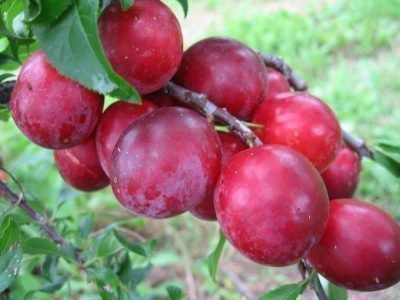

There are a large number of types of plum, hardly anyone has counted the exact number, but the most famous are about forty. Plum is widely cultivated in Russia. In addition to being tasty, plum is rich in vitamins and microelements and, of course, is very nutritious, contributes to the normalization of the functioning of all organs and systems of the body.
The plum is very fertile, rooted well, and multiplies rapidly from the main stem. If you plant different varieties of plum - from early to late, then it will delight with fruits almost all summer, and in spring it will decorate the garden with its flowering. Plum grows on almost any soil, the main condition for fertility is looseness of the soil, but stagnant waters are detrimental to the plant.
Plum care consists in timely pruning, and from the third year of planting it is necessary to apply mineral fertilizers.
As a fruit, plum certainly deserves close attention, it bears fruit well and regularly, does not require labor-intensive maintenance and is very useful for the body.
Stage 1: evaluating conditions
Will fruit trees and shrubs live in my garden?
It depends on the conditions of the site: climate, microclimate, relief, soil and those plants that are going to grow on it.
Most fruit and berry crops are very fond of light. Among them are absolutely all "folk favorites": apple trees, pears, cherries, etc. If these plants cannot stay in the open sun for at least ¾ of daylight hours, they will suffer. But some cultures live quietly if at least half of the daylight hours are illuminated. These are black and red currants, honeysuckle, blueberries and irga. If such conditions cannot be provided, then it remains to plant rowan or viburnum.
The second important factor on which the life of fruit trees depends is the level of groundwater. We can roughly estimate it if we observe the nearest ditch or fire pond during the season. Indirectly, sedges, reeds, alder and aspen indicate the proximity of water. But the abundance of hazel, mountain ash, the presence of bird cherry and oak allow us to plant any fruit crops without fear that they will be disturbed by an underground layer of water. If the moisture lies closer than a meter from the surface, and we cannot change this, then we will have to focus on berry bushes: currants, gooseberries, honeysuckle, sea buckthorn and raspberries.
Fruit trees are very sensitive to the microclimate of their place of residence. For them, cozy, warm corners, protected from the wind and without stagnation of cold air, are best suited.
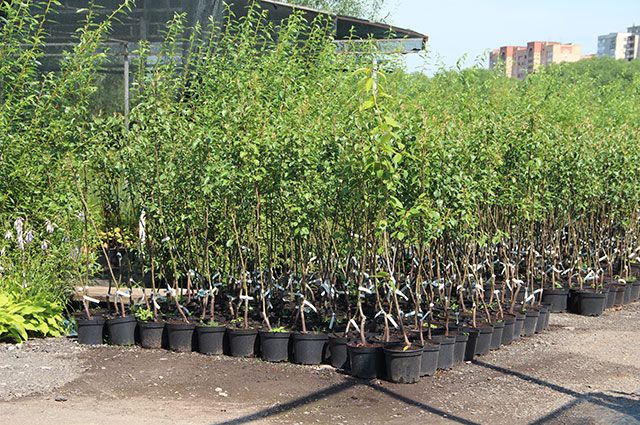

From burns to viruses. How to protect fruit trees and shrubs Read more
Is the soil suitable for a garden?
Fruit and berry plants generally like loose soils that allow air to pass through, but at the same time can retain moisture. They grow poorly on sand, heavy clay, and the soil in drained swamps is too acidic for them.
But you should not be upset: the land intended for a fruit or berry garden can be improved if desired. A lot of humus, peat, sand are added to clay, and a large amount of rotted manure or compost and clay additives are added to sand. The acidic soil is limed. If such a large-scale work is not up to you, you can break it down over several years. In any case, it is quite possible to make a large planting hole and fill it with an improved version of local land.
Who needs watering?
If the possibility of irrigation is not provided, and the plot is dry, then you should not get carried away with crops - "waterlogs" and plant a lot of raspberries, black currants and blueberries.
First, make a preliminary list of suitable plants.
To whom and for what diseases is the plum recommended?
Plum recommends including in your diet for people suffering from anemia and general weakness of the body.
It strengthens the walls of blood vessels well, restoring their elasticity, and therefore is recommended for people suffering from heart failure. The substance coumarin, found in plum fruits, prevents the formation of blood clots and at the same time dilates the coronary vessels. The plum fruit is also good because, due to its unique composition, it removes cholesterol from the body and lowers the level of excess insulin and glucose in the blood. In addition, the plum helps with atherosclerosis (based on the above) and gout.
Plum is also valuable in that it removes toxins from the body, acting like a brush, cleanses and relaxes, normalizes the work of the gastrointestinal tract. Plum is included in the complex treatment of the kidneys, it has a diuretic effect.
In plums, not only fruits are useful, the leaves of this plant also have medicinal properties and are used in folk medicine.
According to scientists, the fruits of the plum bring so many benefits to the body that they must certainly be included in your diet, moreover, preferably fresh, and not processed. They play a positive role in health, support immunity and create a conducive environment for well-being.
Having listed the useful properties of the plum, it should be noted that its fruits are unusually tender, tasty and it is a pleasure to eat them.
Yield and life expectancy of garden plants
| Fruit | Berry | ||||
| Culture | Harvest forecast *, kg | How many years does it live ** | Culture | Harvest forecast *, kg | How many years does it live |
| Pear | Up to 100 | Up to 25 | Viburnum | 6–12 | Up to 50 |
| Apple tree | 80 | 15–25 | Gooseberry | 5 | 15-20 and more |
| Rowan | 15–30 | 25–30 | Honeysuckle | 2 | 20–25 |
| Cherry plum | 10–15 | 10–12 | Red and white currants | 2 | Up to 15 |
| Cherry, sweet cherry | 7–10 | 10–12 | Black currant | 2 | 10–12 |
| Plum | 8–10 | 15–20 | Garden blueberry | 2–3 | 20 and more |
| Sea buckthorn | 5–10 | 12–20 | Blackberry | 2–3 | 10–12 |
| Aronia (chokeberry) | 3–7 | Up to 50 | Raspberries | 0,75 | 10 |
| * With average care ** And gives a full harvest | |||||
Cut back on your list of overly complex or particularly "generous" plants, but add those intended to replace "veterans".
What you need to know
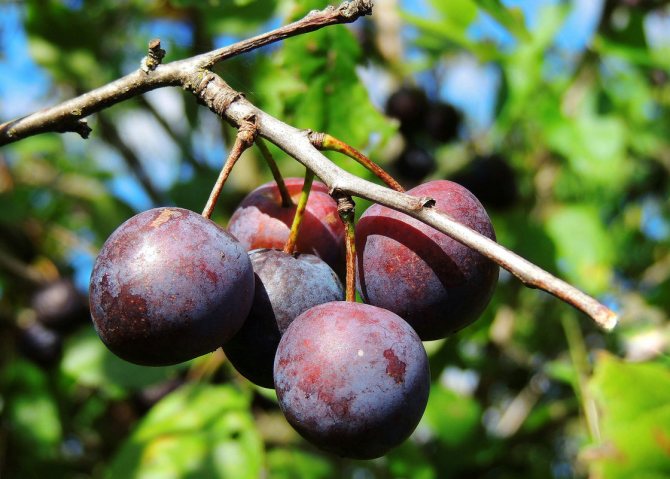

There are very few contraindications for the use of plums and products made from them. But you need to know not only about the beneficial qualities of plums. Not everyone can eat them. For example, people with kidney stones should not eat plums. They contain a lot of oxalic acid, which contributes to the appearance of stones.
Plums should not be consumed by people suffering from diabetes and obesity. It raises blood sugar levels and increases apatite. With a tendency of the body to diarrhea. Plum promotes the removal of fluid from the body, therefore it is unacceptable for rheumatism. And it often causes stomach pains.
Basic rules for choosing a cherry plum seedling
To really buy a zoned cherry plum sapling of the desired variety, you need to contact gardening nurseries, shops and other organizations licensed to sell. When buying a seedling at the market or on the side of the road, you can buy wild of an unknown plant.
Better to buy a 1 - 2 year old seedling.The older the seedling, the more damaged the root system of the culture during digging, which subsequently affects the timing of survival, growth and development of the young tree.
In order for the seedling to quickly take root, it is necessary to immediately plant the purchased copy in a prepared place. Before purchasing a seedling, you must carefully inspect it. There should be no cracks, gum drips, broken roots. The roots must be alive (elastic when bent, white-yellowish in color when cut). The dried roots will not come to life, despite the seller's assurances.
Cherry plum pruning and crown formation
Like all fruit crops, cherry plum is subject to sanitary pruning and crown formation. You can independently carry out sanitary pruning in the autumn. Cut off old, growing inward, diseased and other branches and shoots into a ring. The crown is cut if the shoots are located crowded inside the crown.
The formation of the crown, if there are no skills, it is better to entrust a specialist. Cherry plum forms fruits on the main or peripheral shoots of different ages, which makes it different from other fruit crops. It will be difficult to carry out correctly formative pruning on your own, without knowledge of the biology of culture.
Formative pruning on cherry plum is best done in spring, but before bud break. In winter, formative pruning cannot be performed due to the fragility of the branches, and in summer - the tree is sick for a long time due to wounds inflicted, and hibernates poorly. Correct formative pruning contributes to the prolongation of fruiting and the fruitful period of the culture, rejuvenates it, to some extent protects against diseases, especially infectious ones. At the same time, there are varieties that need autumn crown formation. For example, the Kubanskaya Kometa variety. Therefore, it is better to invite a specialist to form the crown.
Preparing for winter
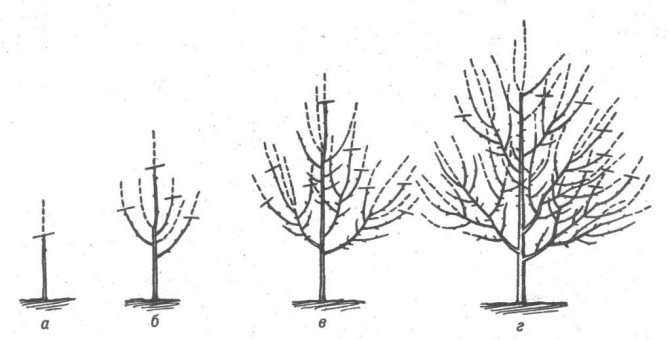

Cherry plum crown formation
Cherry plum is highly frost-resistant. Some winter-hardy varieties can tolerate frosts down to -30 ° C without shelter, so we can say that the plant does not need shelter. Nevertheless, young plants that do not yet have a sufficient trunk thickness can freeze slightly. It is recommended to spud the trunks of young trees to a height of 50 cm, and wrap the upper part of the trunk and the beginning of the skeletal branches with burlap.
back to menu ↑
See also: Peach: growing from seed at home, care features for the middle lane and other regions | + Reviews
VIDEO: CULTIVATION OF CHILDREN (PLANTING, FEEDING, CARE)
See also: Projects of country houses for 6-10 acres: 120 photos, description and requirements. The most interesting ideas
Stage 3: assess opportunities and needs
Will I be able to take care of the garden?
Fruit trees and berry bushes do not require daily hassle. However, sooner or later you will have to treat plants, cut off excess or diseased branches, tie them up, substitute and remove props, sometimes fertilize and water.
Summer residents who do not have the ability or desire to take care of the garden at all can limit themselves to viburnum, mountain ash, blackberry and irga. But, as a rule, this is not enough. When expanding a set, proceed from your resources, but do not have many demanding and complex plants. Do not get carried away with apricot, cherry, cherry plum and sweet cherry. It is also helpful to keep the number of apples, pears, raspberries and blackberries to a reasonable minimum.
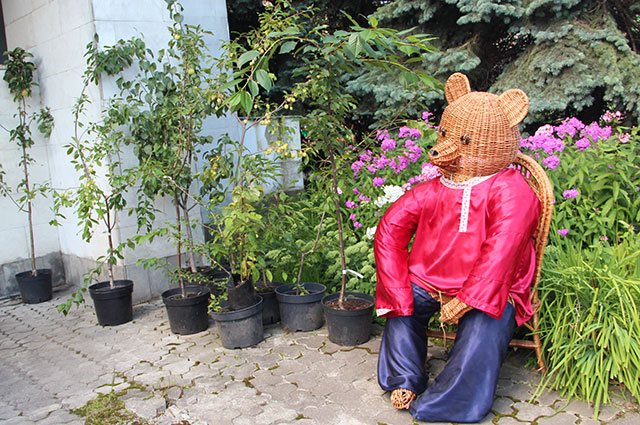

Photo: From personal archive / Elena Popleva
How many fruits and berries will my garden give in the future?
This question is mandatory for summer residents, who, under any circumstances, strive to use the resulting harvest to the last berry. If you are not able to indifferently watch how the fruits fall to the ground, remain for the birds, then ask yourself: how much tasty products do you really need? How much will you be able to eat, distribute, process, or store? Be sure to decide how many fruits and berries will bring you joy and how much will be a burden.Then study the table with our tips and adjust your plans.
When is it time to "grow a shift"?
Among the horticultural crops, there are both long-livers, who have been decorating the site for decades, and sprinters, who have to be planted every 8-10 years (see table). If your pets are not so many years old, but they have already noticeably passed in terms of health and productivity, do not forget to get young plants to replace them this fall.
Content
- Description
- Planting cherry plum When to plant
- Planting in autumn
- How to plant in spring
- Spring care
- When to trim
- How to propagate
How to deal with cherry plum
Plum, cherry and cherry plum very often give root growth, which must be dealt with, otherwise it will take over the entire garden.
How to do it? If you do not need a tree that gives growth, cut it down, drill several holes in the stump as close as possible to the sap-conducting layer and fill the holes with a solution of the Tornado preparation or potassium ammonium nitrate. Cover the saw cut with a piece of plastic or plastic wrap. After 5-7 days, slightly re-drill the same holes and fill in the next dose of the drug and repeat the same procedure in another week. When the shoots die, do not rush to uproot the stump, make sure that there are no roots left that the drug destroying them did not have time to reach.
If you do not want to destroy the tree, you will have to fight the undergrowth. Some gardeners recommend digging up the shoots and chopping them off at the point where the mother plant leaves the root, but experience suggests that it is better not to do this, because two or three grows in the place of one offspring, cut at a depth. Cut off the shoots at the level of the surface of the plot, and if grass grows in the trunk circle, mow the shoots along with the grass. Or grow varieties of cherry plum that do not give growth.
Reproduction
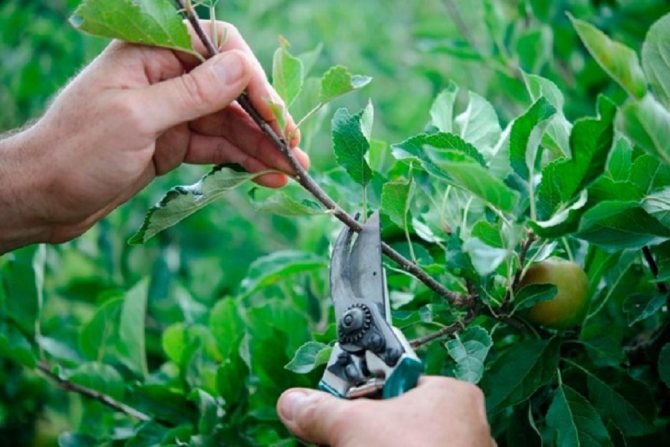

Pruning cherry plum cuttings
Like most horticultural crops, cherry plum can reproduce in one of the following ways:
- cuttings
- layering
- inoculation
- from bone
Cuttings are widespread. The predominant method is to obtain seed from lignified cuttings. Difficult to root varieties (Naydena, Kometa, Shater, etc.) are propagated by green cuttings.
Lignified cuttings are cut in spring or autumn. In the latter case, they are stored at temperatures from 0 to + 2 ° C. Cuttings are planted in May in well-loosened soil. Cuttings are planted obliquely, covering them with plastic wrap after planting. They should be watered and ventilated regularly. After about a month, the film is removed. Such seedlings take 1 to 2 years to grow.
Green cuttings are obtained from the branches of this season. They are germinated in a peat-sandy substrate, covered with plastic bottles. Once they have formed roots, they are transplanted into pots, where they grow over the course of a year. Disembarkation is carried out in May next year. Care for green cuttings is similar - regular ventilation and maintenance of constant soil moisture.
Vaccination is carried out by any convenient method. Cherry plum, plum or apricot can be selected as a stock. The vaccination procedure is standard and does not have any nuances. It is recommended to vaccinate after the start of sap flow (the criterion of which will be swelling of the buds), so that the scion and rootstock grow together faster and take root better. The sites of inoculation into the cleft must be treated with garden varnish.
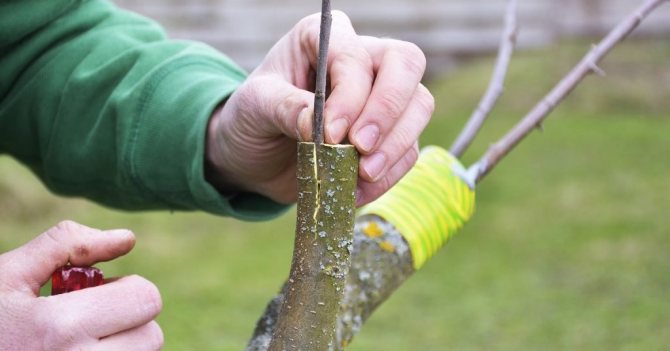

Inoculation of cherry plum into cleavage
Budding, unlike copulation and cleavage grafting, can be done at any time of the year.
Plum, cherry, apricot or peach can be used as rootstock.
Growing cherry plum from a stone is rarely used, since the time to obtain healthy seedlings can be significant - from 3 to 4 years.
back to menu ↑
See also: Pumpkin: a description of the 30 best varieties. General information and classification, varieties for different regions of Russia | + Reviews
Stage 2: Consider the Opportunities
Will the plant fit in my area?
This is the question a gardener should ask himself when buying any seedling! In order not to make mistakes, think of his place of residence in advance, or at least take the cheat sheet below with you to the nursery or garden center. Remember that pretty soon a fruit seedling will definitely turn into a powerful tree, and a berry one into a lush bush. Get ready to give him as much space on the site as is recommended, even if at the time of landing it seems an unaffordable luxury. Finding the necessary free space in a small garden can be difficult - in this case, you need to plan for its gradual release from the current "tenants" for 3-5 years.
And if you plant it densely, and later thin out?
This approach is not suitable for fruit and berry crops. Quite often it turns out that those plants that you want to leave sit on top of each other, and after thinning, they need a difficult and traumatic transplant. The bushes very quickly intertwine into a single whole and it becomes impossible to separate them. It's easier not to plant too much right away!


Photo: From personal archive / Elena Popleva
Can seedlings be planted on the lawn?
Many fruit and almost all berry crops do not tolerate very close proximity to the lawn, since cereals actively take away moisture and nutrients from them. Plants can be planted on the lawn, but only on pre-prepared special "windows" or strips at least 1 m wide. In marked places, sod is removed (by the way, it can be used to repair other parts of the lawn) and a lawn tape or other limiter is immediately dug in along the edges ... Humus or fertile soil is scattered over the opened earth to raise its level, and they dig everything together. Then the seats are marked.
Growing rules
Fruit crops are preferably grown on loamy soils. The site is selected according to the criteria:
- good illumination;
- occurrence of groundwater at a distance of no more than 1.5 m;
- neutral acidity of the soil;
- the area for planting a seedling must be windproof to avoid drafts.
A seedling is chosen that has taken place from grafting, which confirms the authenticity of the variety. The plant should not be broken, damaged, rotten processes. The rhizome is highly developed, containing no dry or damaged roots.
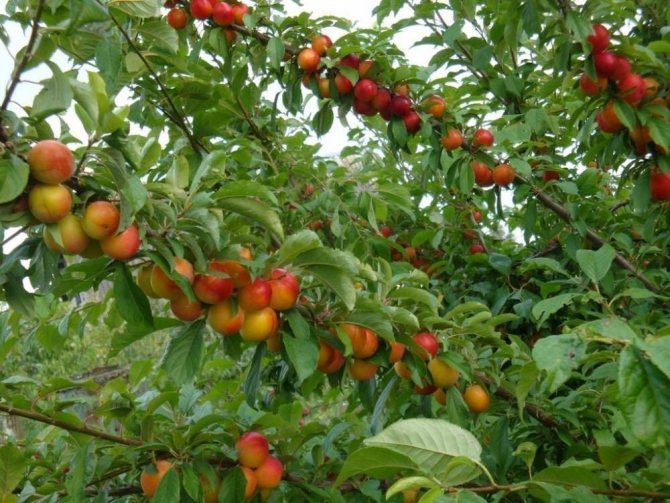

Planting several plants is carried out at a distance of 3 m.
To plant a seedling:
- dig a hole - 50 cm deep, 70 cm wide;
- the upper fertile layer is mixed with humus 10 kg, 150 g of superphosphate and 50 g of potassium salt;
- a mixture of soil with fertilizer is poured into the hole with a slide and the plant is planted;
- carefully align the root system along the embankment and fill the hole to the top with an infertile soil layer;
- tamp the soil tightly, pour 2 buckets of water;
- mulch the near-trunk circle with sawdust.
Eating plums
Undoubtedly, the plum is not grown because the plum tree or shrub is decorative (although wild thorns make an excellent fence through which it is difficult to get through) plants. Plum is grown because its fruits are very tender, tasty and healthy. And if we have already figured out the benefits of plums, then it's time to talk about what and how it is prepared from it.
First of all, fresh fruits are eaten, but plums bear fruit very abundantly, and not all plum fruits (not all varieties) hang on the branches for a long time, so they need to be processed and prepared for future use. Plum fruits can be processed at any stage of ripening.
Beverages
- Plum juice - everyone drank it, it is not only a healthy drink, but also very tasty.Since plum fruits are tender, the juice is obtained with pulp - with it it is healthier, it perfectly increases appetite.
- Pouring is an alcohol-containing drink, but it has a small percentage of alcohol. The liqueur is prepared at home, and each family has its own recipe.
- Slivovitsa is a vodka made from plums. Has all the properties of ordinary vodka, but the aroma and taste of plum.
- Compote - plums are produced both industrially and at home. Plum compote is a delicious, rich and very healthy drink. Excellent thirst quencher.
Jam is made mainly from plum juice with pulp and boiled until it is jelly-like. Confiture is a type of jam. These products are produced industrially, but they can be successfully prepared at home.
Jam is made from crushed plum fruits with a previously removed bone. Jam takes the longest to cook and is an excellent filling for sweet pies.
Jams, confitures and marmalades can be made from absolutely all sorts of plums.
Jam
Jam is made from both pitted plums and pitted plums. Plum jam is a very tasty product and the result of the necessary processing of plum fruits. Plum jam is usually made at home, but the industry also produces it. Jam can be either instant or long-boiled. Jam is a primordially Russian product - boiled berries in sugar syrup.
First of all, this is a delicacy that is liked not only by children, but also by adults. It can be prepared both industrially and at home - from plum fruits. Pastila and marmalade can be made with fillers such as nuts. Candied plum fruits keep well and are an excellent addition to tea.
Not all plum fruits are suitable for the preparation of this delicacy, but only black plum and Hungarian Italian plum, homemade, and it is also made from small raisin-eric plum. But if you figure it out, you can dry any plum, it just won't be the well-known dried prune, but just a dried plum. The process is long, but not very laborious, but the result will delight lovers of sweets in winter.
In addition to sweet preparations, various sauces, marinades and seasonings can be prepared from plums.
Pickled plum
It is better to marinate plums of sweet varieties, but if you need a plum for seasoning, you can also marinate more sour varieties. Pickled plums are a great addition to meat, especially red meat, and turkey.
From any plum, you can get an excellent seasoning, both for meat and game, in addition, this product is well stored and is in demand in baking. The seasoning can be made with nuts as well as cloves and cinnamon, and star anise and nutmeg are great with plums.
Plum sauces are produced industrially, but they can also be prepared at home, combining plums not only with seasonings, but also with vegetables, such as zucchini, pumpkin and tomatoes, adding garlic and horseradish, the main thing is to observe the measure and proportions. Any sorts of plums are used in sauces, but sour ones are better.
Plum can not only be processed in the same ways that are described above, but also soaked, dried and harvested in jars without sugar at all, by pasteurization. Plum is well stored, for a very long time, the main thing is that it is better to harvest it without pits for long-term storage.
When and where did the Russian plum appear
The history of the distribution of cherry plum begins in the North Caucasus and Central Asia and is about 3000 years old. For a long time, the fruit plant remained wild and its taste was not particularly appreciated. Only from the middle of the 19th century, cultivated and unpretentious fruit trees began to be cultivated in many countries with a temperate climate.
Cherry sliva is used in horticulture: its seedlings are considered good rootstocks for apricot and peach, and its excellent flowering made the tree attractive for landscape design.
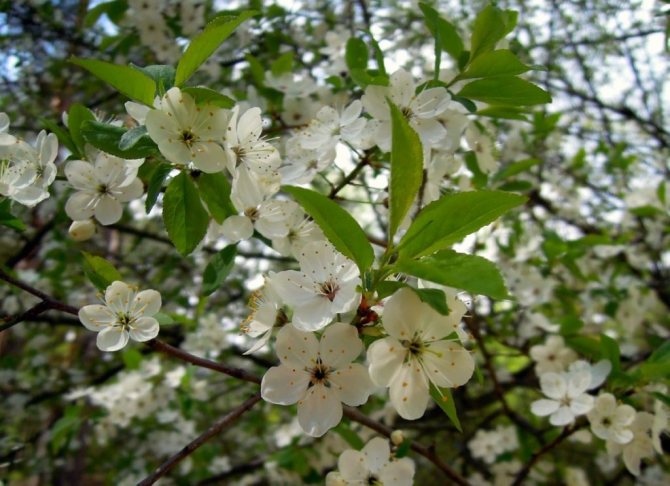

Cherry plum blossom

